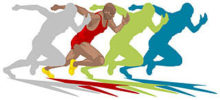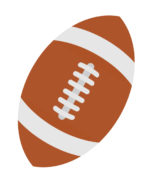Cultural Comparison: Canadian Ice Hockey vs. American Football, Part IV
Vincent A. @ ELC Research International

In the preceding parts, I first raised the question that, while ice hockey and American football have a similarity in that they are both the No. 1 sports in Canada and America, respectively, there is a clear difference in that violence such as fights occur frequently in ice hockey games whereas these seldom occur in American football games. Why is this? Then I pointed out that the history and cultural background that have guided the development of sports are totally different in America and Canada, and described particularly the influence of the American Revolutionary War in the U.S.A. In Part II, I would like to explain how American football, which was originally a very bloody sport, has overcome its brutality, and then compare it with ice hockey.
Dilemmas That Annoyed Faculties
American college athletics, which were budding as extracurricular activities for university students early in the 19th century, achieved great popularity as intercollegiate athletic games began to be played. In particular, football became the leading competition in college athletics because of its physical power. However, football was really, at that time, a violent sport and casualties occurred frequently. Why did such a dangerous sport evolve into one, as we can see now, where brutality is almost gone? I believe it is because, on one hand, college athletics, including football, were part of the controversial area of extracurricular activities for students and, on the other hand, that university faculties had struggled to resolve the problems posed by extracurricular activities quite sincerely although quite distressed by them.
The most fundamental dilemma with regard to college athletics, bothering faculties, was an antinomy that the more college athletics expanded, the more the mission of the university in society became difficult to achieve.
The mission of the university, higher education, is in a wider sense, to create and preserve knowledge and pass on it to society and younger generations. To achieve this mission, faculties need to work hard in their education and research activities and students in their learning activities. However, as college athletics expanded, winning in popular intercollegiate athletic games became about more than just the honor of players. It became a good opportunity to enhance people’s recognition of the name of the university and to create a powerful appealing image of faculty who were shaping youth who had superiority not only in the intellectual realm but also in the physical one. But, despite the degree to which college athletics acquired wide popularity or the reputation of the university was boosted, college athletics were, in the end, extracurricular activities for students.
The principal occupation for students was to attend the classes and worship as well as to study in their dormitories during prescribed hours, as most American universities in those days were private schools founded by religious denominations and had students living in dormitories. However, in order to participate in intercollegiate athletic games, students had to be absent from classes or worship at times. Furthermore, if the game was held in another town, remote from the university, they had to travel there to attend. Faculty attempted to control the students’ activities by using the authority given to them, as much as possible: by limiting exercise hours; by not approving students’ absence from classes or worship; and by objecting to students’ participation in intercollegiate games. However, they could not easily control the enthusiasm of university students who had recognized the value of the freedom which had been revealed by the American Revolutionary War. Furthermore, most American universities were private schools and they had to secure fresh students every year in a society in which there was a trend toward a growing number of universities. So, the universities had to make themselves sufficiently attractive for both the students and the parents. As a result, Faculty were not allowed to unconditionally forbid students’ sports activities or participation in intercollegiate athletic games because these were a strong attractor for the university. The faculties were caught in this dilemma for decades.

You may not think of it as a serious conflict between the universities’ mission and the faculties’ worry that extracurricular sports would get in the way of the accomplishment of that mission. However, those who are members of college faculties, like myself, could be said in general to be relatively sensitive to the role their jobs play in society. This may be slightly different from people engaged in non-academic jobs in society. Besides, most faculties in those days were comprised of more or less earnest church ministers. It is not difficult to imagine that they were quite nervous about the adverse effects of college athletics on the students’ studies.
Another dilemma that bothered the faculties was the conflict between amateurism and both commercialization and professionalization of sports. The question of commercialization can be divided into the issues of large prizes (of cash or goods) and game ticket receipts, and professionalization into the issues of employment of paid professional coaches, the eligibility of players and holding games with professional teams. Actually, American college athletics had been exposed to huge waves of commercialization and professionalization, since its beginnings.
More specifically, when intercollegiate athletics gained great popularity and it was discovered that college sports lead to commercial profits or stimulation of the local economy, enterprises or cities/towns begun to financially support and help hold intercollegiate athletic games. Also, some organizations would offer a large prize to the winner of the game. Because the prize was so attractive to student athletes, it created in them a trend of craving the victory for the prize, an attitude which was totally incompatible with amateurism.

Amateurism was, originally, a discriminatory and exclusive concept devised by people of the British aristocracy to shut those of the working classes out of the “elegant play” of sports. It was based on the thought that those who needed to work to earn their daily bread should not be eligible to participate in sports. During the American Revolutionary War, America sent a “Dear John letter”, more specifically, “the Declaration of Independence” to Britain, a letter from a nation in which there was no aristocracy as there was in Britain. Therefore, amateurism in America was not as rigid as in Britain. Nevertheless, the American universities had to appear to society as if they were respecting the spirit of amateurism. This was necessary so as avoid criticism of commercialization and professionalization of college athletics.
The employment of paid professional coaches was a very difficult issue. As the significance of winning the game became greater, the game strategy and the training methodology needed to increase in sophistication. In fact, Yale and Harvard which were the most prestigious schools in college athletics employed professional coaches in their regatta teams as early as the 1860’s. Since the beginning, the incompatible ideas that college athletics had to appear to society to be respecting the spirit of amateurism on one hand, while they had to take professional methods in order to win the games on the other hand, had been an uninterrupted annoyance for college faculties.
The third dilemma that was annoying faculties was an ironic one, and I believe this must be the most serious issue: in order to make college athletics exactly as the faculties desired, it was necessary to control every detail of the students’ activity and, of course, the faculties wanted to do that. However, in reality, they had no spare time to administer the students’ extracurricular activities, or special knowledge of how to do it. Thus, in the end, they had no option other than entrusting the operation of college athletics to students. For example, even a single intercollegiate athletic game required complicated management procedures including negotiation with the opponent school team, approval of the faculties, reservation of an athletic ground, reservation of transport facilities, reservation of accommodations, etc. Furthermore, with regard to the training regime, in order to devise an effective training method when victory was regarded as quite important, adequate technical knowledge was required. The faculties, who had no spare time for the students’ extracurricular activities, or skills for organizing them, were able to interfere with the college athletics only by restricting the students’ self-governing activities based on their ability to grant or deny approval.
Copyright ©2013-2018 Japanese Canadian Community Organization of Victoria
This article is a revision of the article entitled “In-Depth Cultural Comparison, No. 2: Comparing Canada and America; Ice Hockey vs. American Football” printed in Japonism Victoria, vol. 8 no.3, 2013 published by Japanese Canadian Community Organization of Victoria.
Canadian Ice Hockey vs. American Football, Part I <
Canadian Ice Hockey vs. American Football, Part II <
Canadian Ice Hockey vs. American Football, Part III <
> Canadian Ice Hockey vs. American Football, Part V
> Canadian Ice Hockey vs. American Football, Part VI
> Canadian Ice Hockey vs. American Football, Part VII
